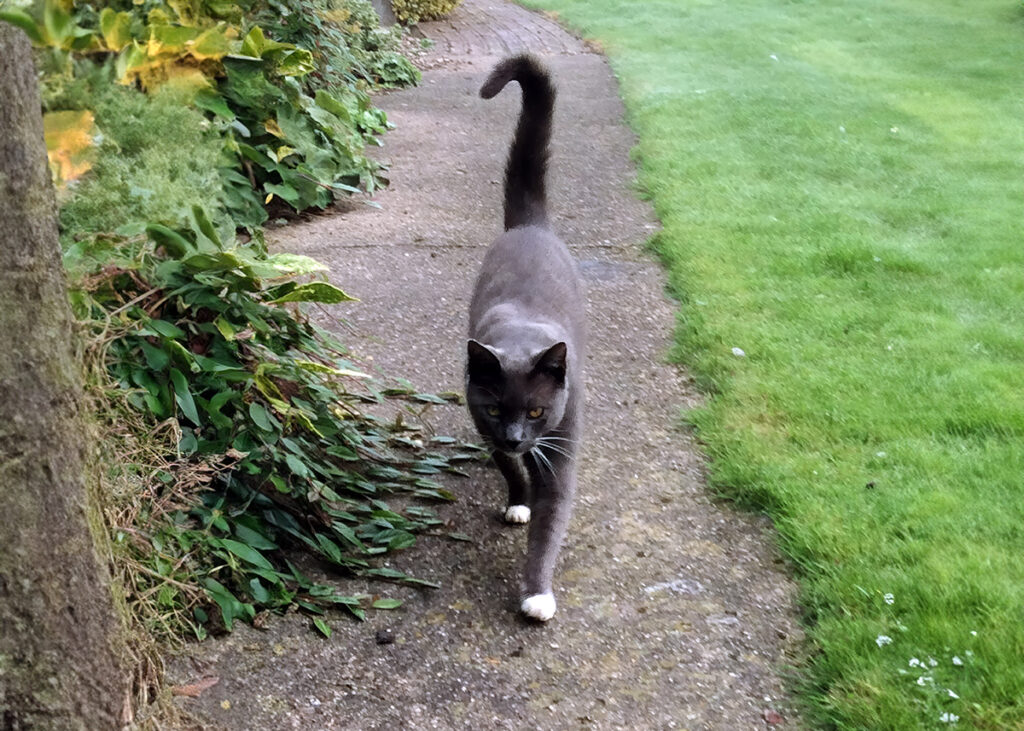Understanding Common Feline Behaviours
 Copyright Caroline Clark
Copyright Caroline ClarkAll cats are individuals and have their own personality types. However there are a number of common behaviours that most cats exhibit. Knowing what some of these are and what they mean helps us understand and appreciate them just that bit more.
As a feline behaviour counsellor, here are some of the most common questions I get asked:
Why does my cat raise his tail like a question mark when he sees me?
This is a greeting and is usually shown to members of cat that belong to the same social group. It’s their way of saying hello to you!
Why does my cat choose the bird bath over his water bowl?
Cats have particular preferences to the way water is presented. However most prefer the bowl to be made out of ceramic or glass rather than plastic as that material taints the water. Wide openings to prevent their whiskers from being crushed seem to be favoured too. They also prefer to drink away from their food so dual bowls are not a good idea. Some like running water so using water fountains can help encourage drinking. Because cats are prone to kidney problems as they age, it makes sense to give them water in the most acceptable source possible.
Why does my cat knead me when I am stroking him/her?
This is a sign of security and shows that they feel safe with you. It has associations with being with their mother. When kittens suckle, they pad alternately on either side of the teats to help express milk. Certain textures can trigger this pleasant memory too which explains why some cats exhibit the behaviour when they are on a fluffy material. Some cats will even salivate excessively when being cuddled and this is thought to be linked to the emotion of anticipating the milk feed.
Why does my cat rub around my legs?
Scent profile is very important to cats. They have numerous scent glands around the face, body and tail that distribute pheromones. These pheromones are unique to each cat. Sharing this scent between other cats shows that they are part of the same social group and is only done if they are affiliated to one another. So you should feel quite honoured that your cat is anointing you with their scent!
Cats will also rub on objects in the home. This is because being able to smell themselves gives them a sense of security. That explains why some cats can show signs of distress when there have been renovations or new decorations in the house.
Why does my cat like to scratch with his/her claws?
Cats are highly driven to scratch and this innate behaviour is believed to serve the following purposes:
- Visual territorial marking – this informs other cats about their presence in a given area
- Claw conditioning and exercising the fore limbs (important for predation)
- Marking – glands in between the toes help to distribute their scent
There is a new product on the market called Feliscratch that can help to redirect them to scratch on a more appropriate surface
Why does my cat like catnip?
Cat nip is a plant (Nepeta cataria). The active chemical in the plant is called nepetalactone which is harmless and has been likened to LSD without any of the side-effects.
Around 80% of cats seem to be attracted to its scent and act in an excited manner when they smell it. This includes rolling around on top of it and vocalising. Catnip toys can be used as environmental enrichment or to mentally stimulate in-door cats.
Why does my cat prefer non-cat people?
For most cats – Less is more! They tend to feel threatened by the stranger that makes a direct move towards them, puts out their hands or stares at them. The person who is non-catty therefore is more likely to attract them!
Recommended Products
- Feliscratch is composed of a synthetic copy of feline interdigital pheromone
- The blue color in the solution inside the pipette simulates lacerations and tells the cat where to scratch (the blue markings even fading remain visible)
- Synthesized pheromone stimulates the natural behavior of scratching in places where the product is applied
- Great product
- PENGUIN GROUP
- Bradshaw, John (Author)
- English (Publication Language)
- 336 Pages – 08/07/2014 (Publication Date) – Penguin (Publisher)
I may receive commission when you click Amazon links on this page and make a purchase. However, this does not impact my recommendations, reviews or comparisons.
Want to learn more?
Here’s a selection of our courses which may help you understand more about feline behaviour.
Advanced Certificate in Feline Fear, Anxiety & Aggression
- Accredited Course
- 4 Hours of Webinars
- Downloadable Resources
- Certificate of Completion
- Lifetime Access
Introduction to Pet Anxiety Webinar
- Recorded Webinar
- Downloadable Resources
- Certificate of Completion
- Lifetime Access



